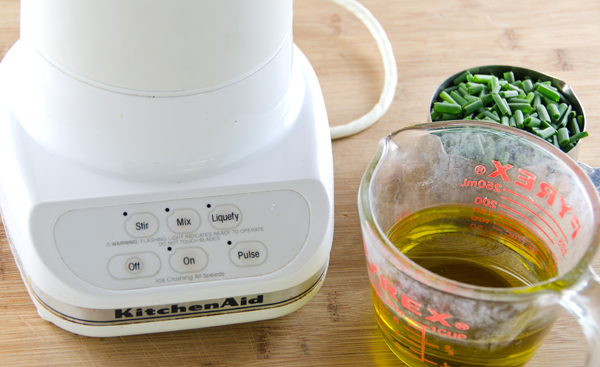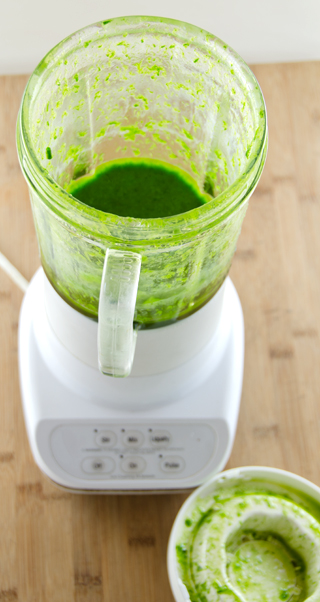 Just exactly what is a bunch? That is the question I had to pose after looking at Bon Appetit ‘s June issue.The current issues of both Bon Appetit and Fine Cooking have extensive articles about cooking with herbs. The article and recipes in Fine Cooking were contributed by Aimee Olexy. We had the pleasure of dining at her Philadelphia restaurant,Talula’s Garden last year. The article is a wealth of recipes that use fresh herbs, in everything from a grain salad to a pound cake. There is also a page that gives the reader the basic formulas for herb butters, oils, vinegar, syrup etc. Bon Appetit devotes ten pages, if you count photos, to a spiked lemonade, tea, dessert, a board dressing and chive oil, among others. Chive oil caught my eye since our chives are peaking and I am trying to find ways to use them in my everyday cooking. This is where the bunch question arose.
Just exactly what is a bunch? That is the question I had to pose after looking at Bon Appetit ‘s June issue.The current issues of both Bon Appetit and Fine Cooking have extensive articles about cooking with herbs. The article and recipes in Fine Cooking were contributed by Aimee Olexy. We had the pleasure of dining at her Philadelphia restaurant,Talula’s Garden last year. The article is a wealth of recipes that use fresh herbs, in everything from a grain salad to a pound cake. There is also a page that gives the reader the basic formulas for herb butters, oils, vinegar, syrup etc. Bon Appetit devotes ten pages, if you count photos, to a spiked lemonade, tea, dessert, a board dressing and chive oil, among others. Chive oil caught my eye since our chives are peaking and I am trying to find ways to use them in my everyday cooking. This is where the bunch question arose.
Bon Appetit’s recipe calls for 3 bunches of chives and 1 1/3 cups of grapeseed or vegetable oil. Gourmet Sleuth says 1 bunch of chives = 1/2c chopped, I’m not sure on what authority they have determined this. One CSA farm cooperative labeled a bunch at one ounce, another more generous with a 2 ounce measurement. Oh yes, there’s an app for that, Produce Converter. Basil, parsley and oregano made the cut, sadly no chives.
So I returned to my old tried and true recipe from the Herbfarm Cookbook. A book that is open in my kitchen all summer long, author and former chef of the Herbfarm restaurant, Jerry Traunfeld is more exacting in his measurements. His ratio of 1 cup of coarsely snipped chives to 3/4c extra virgin oil worked well for me. Bon Appetit’s recipe heats the oil for a more concentrated mixture. Aimee and Jerry’s recipes rely on the heat that is generated by the blender.
So is it better to make this in a food processor or a blender? All three articles agreed that the initial way to combine the herbs and oil is in a blender. Blenders are best suited for liquid preparations, pureeing, emulsifying and blending. Food processors are better at shredding, chopping, slicing and grating. Even though the bowl of a food processor is large, liquids in it can be no higher that the blade or it will run out the sides, I can certainly attest to that. A blender bowl can be filled almost to the top without the contents leaking out.
Any herb oil must be stored in the refrigerator for safety reasons. Botulism can occur when fresh herbs and oil are combined and left at room temperature. The equation for spoilage is even greater if garlic is added to the recipe. Ms Olexy gives a shelf life of two days to her herb and garlic oil. All fresh herb preparations are at their best in the first few days. After topping salmon with it, adding it to a vinaigrette and using it in a sauce for chicken, I’m sure I will have to make a new batch in a few days.
Chive Oil
Makes 1/2 cup
Ingredients
- 1 c coarsely chopped chives
- 3/4c extra virgin olive oil
Directions
- Put the chives and oil in a blender and puree until the oil begins to warm, 2 to 3 minutes.
- Pour the oil into a very fine strainer, or a coarse strainer lined with a double layer of cheesecloth, set over a bowl. Let the oil drip for one hour or longer to extract as much as possible. The oil should drip undisturbed to achieve the clearest oil. Discard the contents of the strainer and store the oil in a covered container in the refrigerator. Bring to room temperature before using. Will keep for a week.



